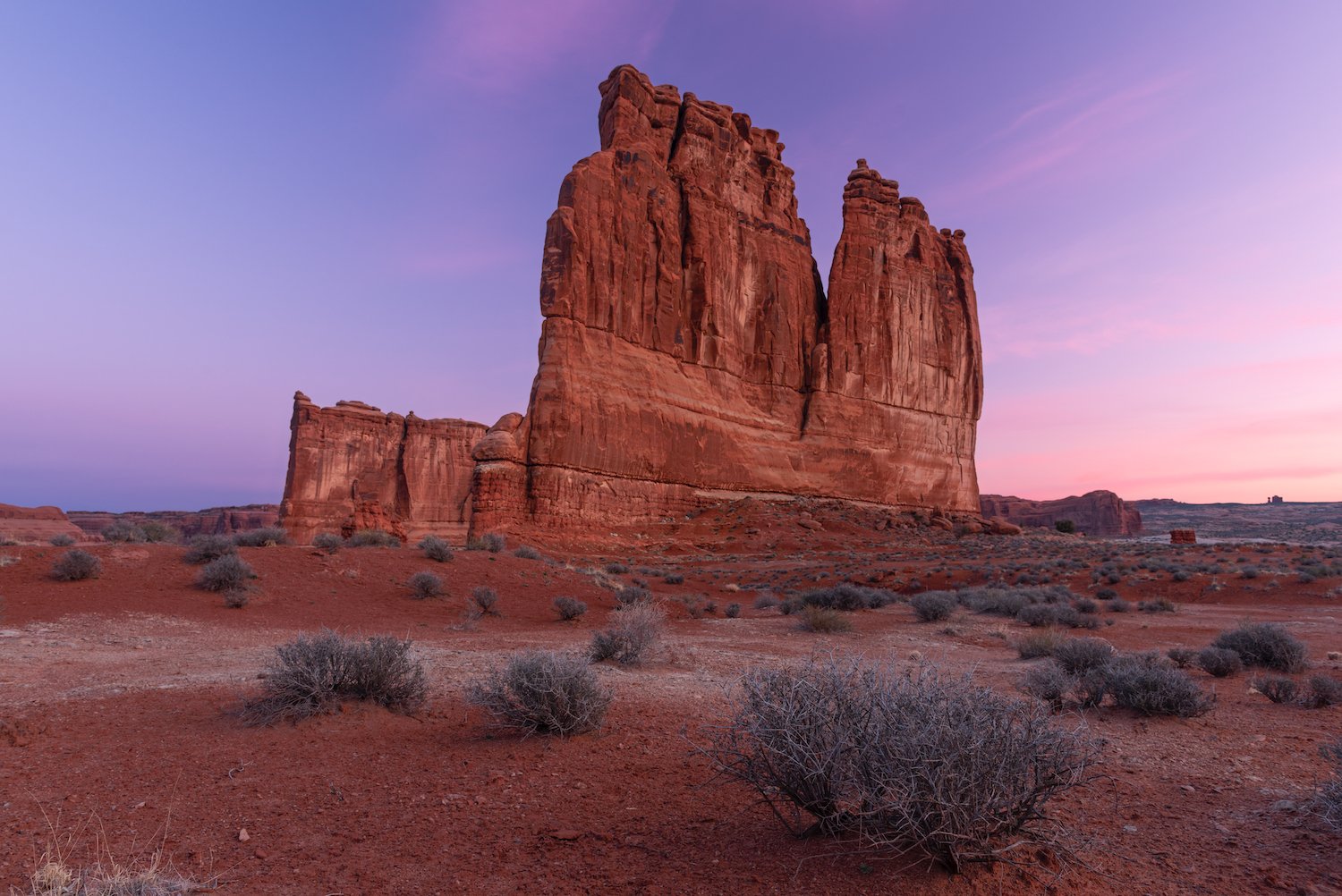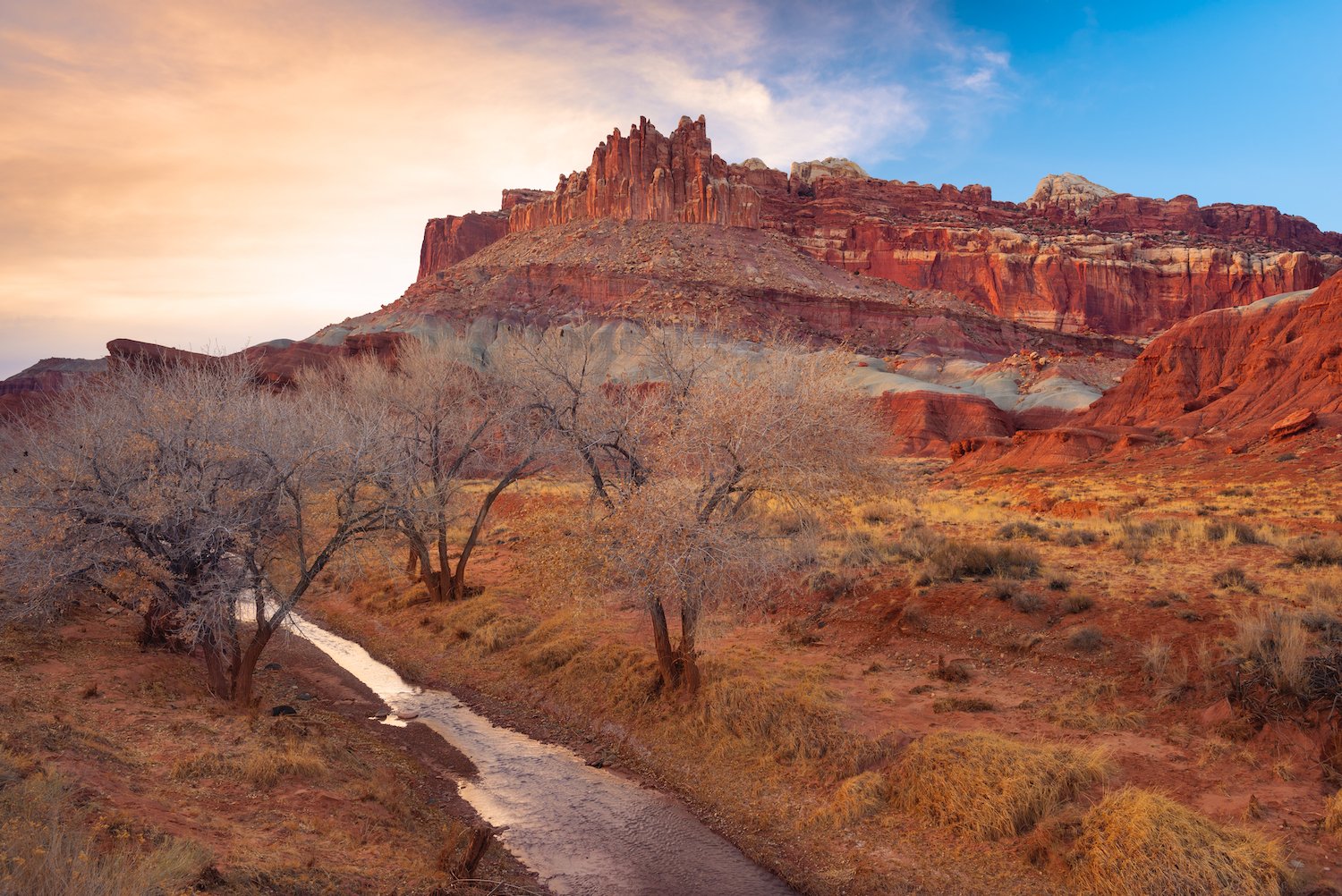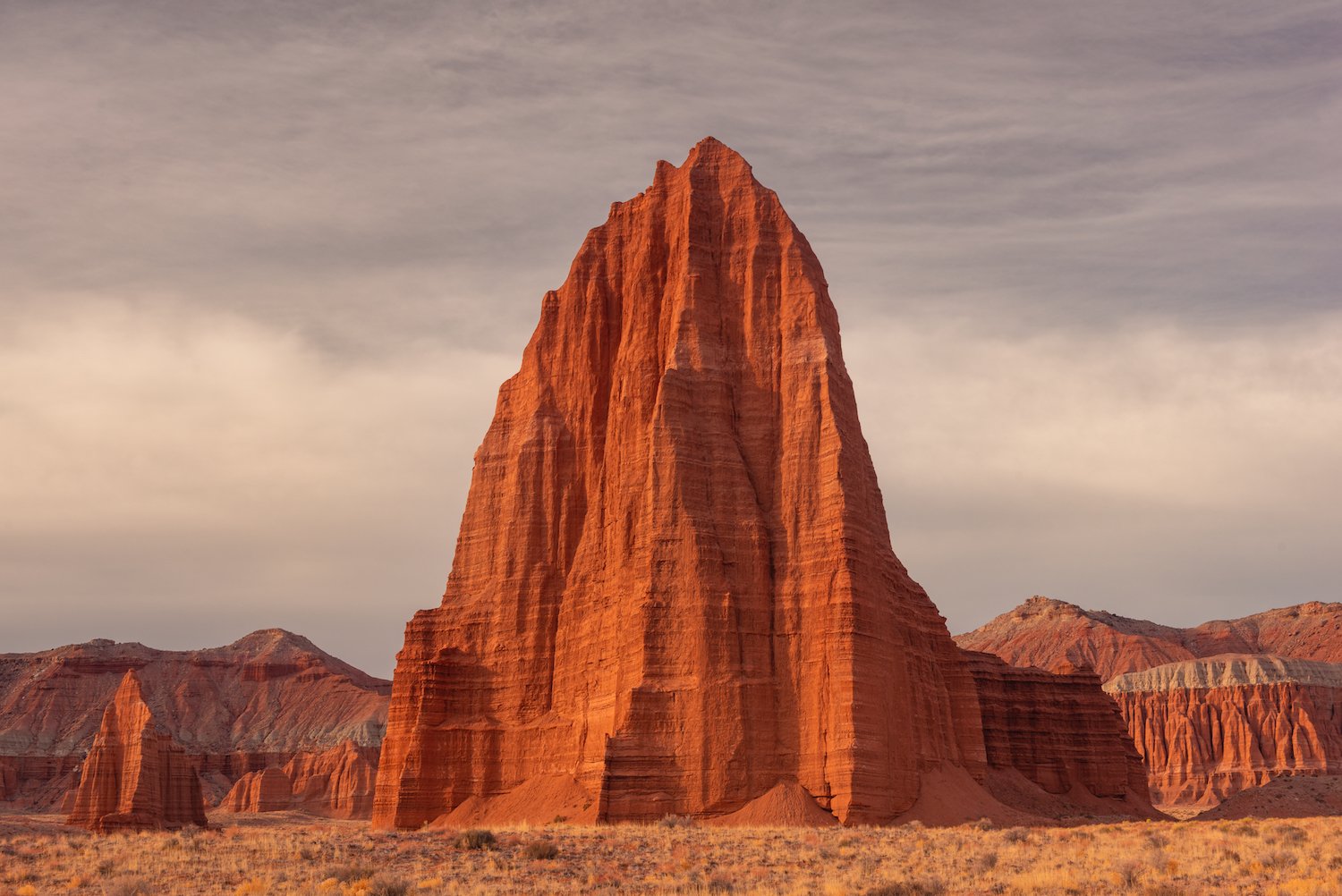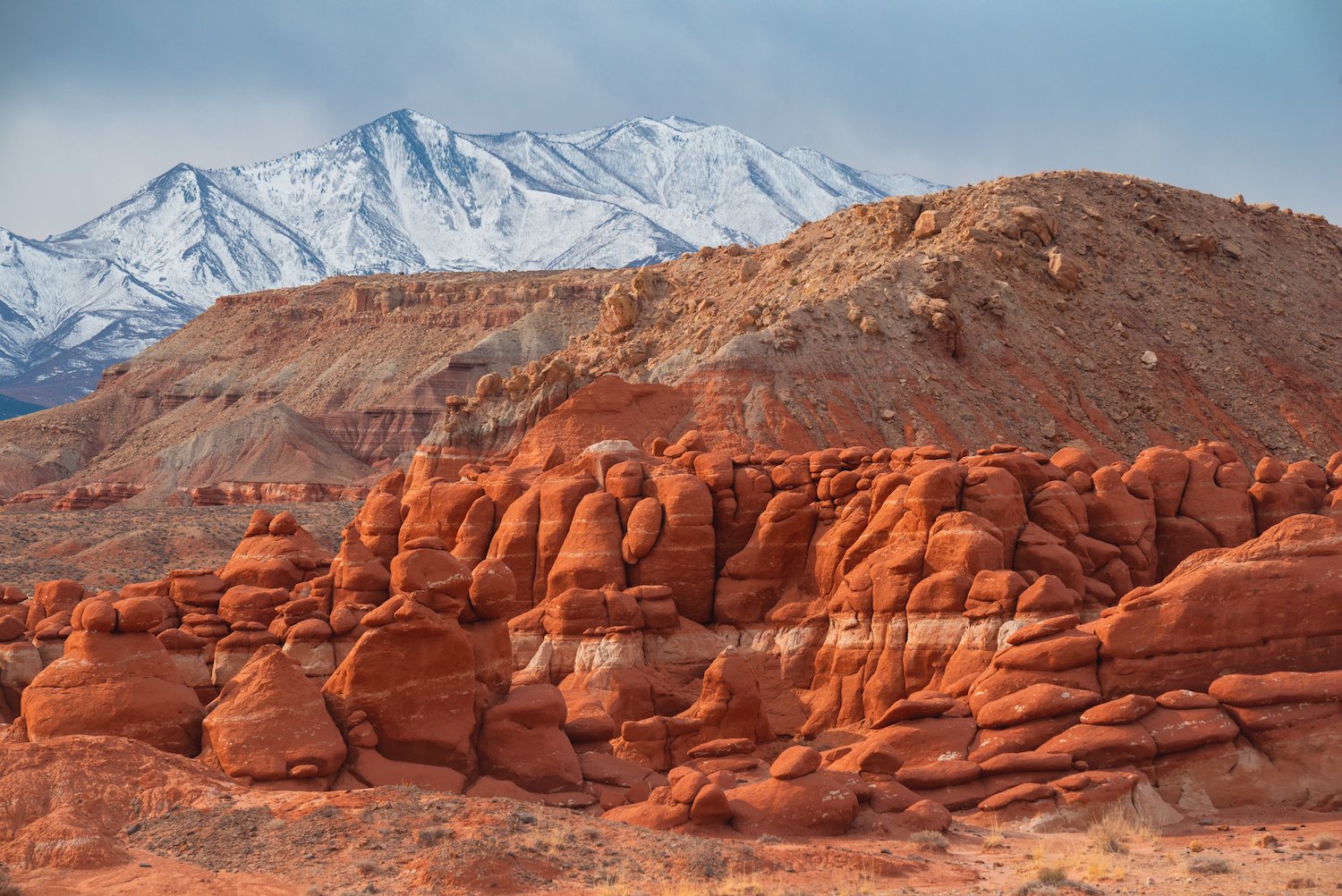Arches national park
Arches is one of Utah’s most popular parks and known globally for its beautiful geological formations - many eroded into gorgeous arches that look virtually manmade. The “Windows” section of the park is a great introduction containing North Window, South Window, Turret Arch, and Double Arch, all easily accessible from the parking area. North Window is especially brilliant during sunrise as the morning light pierces through it and lights up nearby Turret Arch. During sunset, I recommend capturing a more distant view of the “Windows” monoliths from the road with the snowcapped La Sal Mountains in the background.
Turret Arch
Double Arch
Further north, the park’s Devil’s Garden section offers a more robust network of trails around several arches and natural bridges. One of them, Landscape Arch, is the longest arch in the country and among the longest in the world. Another, San Dune Arch, is situated in a wonderful little narrow canyon surrounded by grasslands.
Erosion has also sculpted incredible freestanding towers, buttes, and fins throughout the park. The mighty Courthouse Towers is definitely a highlight right off the park road. And no description of Arches would be complete without mentioning Delicate Arch, the icon of Utah, situated in front of a huge, panoramic vista.
Landscape Arch
Courthouse Towers
Sand Dune Arch
canyonlands national park
Canyonlands is classic Southwest desert beauty. The park’s vastness and immense views are absolutely stunning. It may not have the same notoriety as the Grand Canyon, but it is my favorite national park in the Colorado Plateau for its diversity and spaciousness. Canyonlands is divided into three sections: Island in the Sky, The Needles, and The Maze. The first two are covered here.
Island in the Sky is a huge mesa that towers high above deep canyons that were carved over millions of years by the meandering paths of the Colorado River and Green River. The elevated views from the mesa into the canyons are incredible to photograph during sunset and sunrise. Three vistas in particular - Green River Overlook, Grand View Point Overlook, and Buck Canyon Overlook - form the heart of this park district and are each epic in their own right.
Grand View Point Overlook
Green River Overlook
Buck Canyon Overlook
Canyonlands is also home to Mesa Arch, a natural feature that’s very popular during sunrise. As the sun rises above the distant horizon, it illuminates the underside of the arch in a warm glow. The view is a favorite among landscape photographers and, increasingly, the general public. Another far less known trail is “False Kiva,” whose path leads to both an ancient ruin and an incredible view of a remote valley dotted with huge mesas and buttes. Prior research on this trail is required as the trail is not acknowledged by park maps.
False Kiva view
Mesa Arch
Hikers and backpackers should focus on exploring the Needles section of Canyonlands. There are a number of long and short trails that intersect the multicolored, vertical rock spires that the region is known for. The massive Druid Arch is an icon in the area and located at the end of a fairly easy 9-mile roundtrip hike. If it were more accessible it would no doubt be mobbed by tourists because it is as impressive and epic as Delicate Arch in Arches NP, which is visited by thousands.
Druid Arch
Dead Horse Point State Park
Dead Horse Point lays outside the boundaries of Canyonlands but offers a similar, epic views of the Colorado River. The state park’s East and West Rim trails form an eight-mile path along the overlook but the best views may be from right near the carpark for a view of a horseshoe bend in the river’s meander.
Marlboro point
Marlboro Point is another “Island in the Sky”-type vista just outside the boundaries of the national park and one of my favorite in the region. The view of partially eroded wall of buttes rises from the valley extending high into the sky is spectacular. This place is wonderful for both sunrise and sunset photographs.
Goblin Valley State Park
It’s difficult to pinpoint an area of Utah with a greater concentration and diversity of hoodoos and other contorted rock formations than Goblin Valley. This state park is absolutely packed with bizarre formations molded over the years by water and wind. Photographically speaking, the place is best captured by focusing on individual hoodoos and shooting them during the golden hours when the soft colors are most vibrant.
Leprechaun Canyon
Utah is filled with awesome slot canyons but Leprechaun Canyon is particularly notable for its tall walls and colorful sand. The path is conveniently located off of Highway 95 but few people visit, offering wonderful solitude.
Little Wild Horse Canyon
This little slot canyon near Goblin Valley is an easy hike through narrow passages and around small rock obstacles. The best part is about a mile and a half from the trailhead in a section where the rock walls converge, pointing to the trail.
The Castle
Capitol reef national park
Perhaps the least known and appreciated of Utah’s national parks but one of its most scenically diverse, Capitol Reef protects a number of colorful canyons, huge cliffs, and rock formations. A few geological wonders serve as notable landmarks, including Pectols Pyramid, The Castle, and the beautifully eroded Fluted Wall, conveniently located off of Highway 24 - the main road through the park.
Besides its natural wonders, the park is also home to a number of historic Mormon settlements - including the Behunin Cabin, Fruita School, and the Gifford farmhouse - that attest to the difficulties faced by these pioneers in settling this arid landscape.
Pectols Pyramid
Fluted Wall
cathedral valley
Cathedral Valley is one of the major highlights of Utah and the most beautiful section of Capitol Reef NP. Massive sandstone monoliths thousands of feet high rise from the valley floor appearing like gothic cathedrals in the desert.
Because this jaw-dropping valley requires at least a high-clearance two-wheel drive vehicle to traverse its 58-mile bumpy road, most park visitors are discouraged from visiting, leaving it free from major foot traffic. Along the valley road, visitors are treated to surreal badlands, huge cliffs, and colorful rock. However, the main highlights are two enormous sandstone formations named Temple of the Sun and Temple of the Moon that light up in a beautiful glow during sunrise.
Temple of the Sun
Temple of the Moon and Temple of the Sun
Factory Butte
Just west of Capitol Reef NP a huge formation that looks like a massive industrial building dominates the skyline. Like everything around it, Factory Butte was sculpted by the wind and water and its complex shape attests to nature’s artistry. It is situated among badlands that share its color and bleakness.
Unfortunately, the Bureau of Land Management recently decided to open up the surrounding badlands to ATV recreation, which may forever alter the landscape. For now, there are still unspoiled sections where fissures and crevasses serve as great foreground to photograph the formation.
Little egypt
This relatively unknown spot is a favorite among hoodoo or “goblin” enthusiasts. The sandstone that once formed a continuous piece of rock has been eroded by the forces of nature and broken down into little formations. Similar to Goblin Valley State Park, it’s easy to let the imagination run wild and “see” figures, people, and animals in the rocks. The setting for this geological area is also quite remarkable with epic views of the Henry Mountains in the distance.
Glen Canyon
When the Glen Canyon Dam created Lake Powell and inundated the massive walls of Glen Canyon, the Southwest lost a beautiful place. Countless side canyons, grottos, arches, coves and other natural formations have been lost to the water. Nevertheless, due to drought and climate change, Lake Powell’s water level has been dropping for years, revealing more of the Canyon and its original splendor. For now, the best way to get around the Canyon is by houseboat to explore its many arms.
Cookie Jar Butte
The Big Pool
There are simply too many incredible features in the Canyon to list but one of its most beautiful and infamous is Cathedral in the Desert. The Cathedral is a huge natural amphitheater set among colorful striped rock. Its size, color, shape, and beauty combine in an amazing display for those who trek out to experience it.
Kayaking Cathedral in the Desert
Bradley Cove
Kayaking Cathedral in the Desert
Dominguez Butte




































